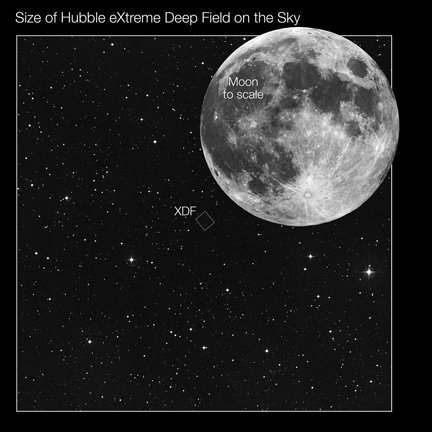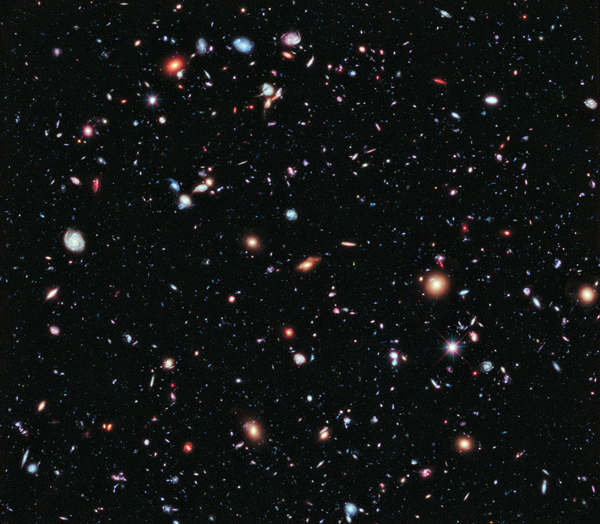Hubble 'extreme deep field' captures oldest galaxies yet seen
09/25/2012 05:39 PM Filed in: Space News | Space Science
By WILLIAM HARWOOD
CBS News
A stunning new composite photograph from the Hubble Space Telescope, made up of more than 2,000 images shot by multiple cameras over the past 10 years and combined in what amounts to a 23-day time exposure, shows some 5,500 galaxies in tiny field of view, including some dating back to just 450 million years after the big bang birth of the universe, astronomers said Tuesday.
Dubbed the eXtreme Deep Field, or XDF, the photograph represents the deepest view of the universe yet achieved, giving astronomers a "time tunnel"-like glimpse back across 13.2 billion years of cosmic history.
"The XDF is the deepest image of the sky ever obtained and reveals the faintest and most distant galaxies ever seen," Garth Illingworth, a Hubble researcher at the University of California at Santa Cruz, said in a NASA statement. "XDF allows us to explore further back in time than ever before."
Earlier observations of pulsating Cepheid variable stars in remote galaxies allowed Hubble astronomers to conclude the universe is roughly 13.7 billion years old. The XDF photograph represents a look back across time from the present to within 450 million years of the big bang, showing the broad spectrum of galactic evolution in a single image.
Mature spiral galaxies that look similar to Earth's Milky Way and nearby Andromeda can be seen, along with spherical ellipticals and smaller, dimmer infant galaxies from much further back in time.
"So we (see) a time when the first galaxies were forming, the metals, all the elements that make our bodies, make the Earth and basically our whole solar system were starting to be built up in this time," said Illingworth. "So it was a time ... when the universe was being transformed, the first galaxies were being built up, a dramatic time in the life of the universe."
The Hubble Space Telescope was aimed at a small patch of sky in the southern constellation Fornax where an earlier time exposure called the Ultra Deep Field was taken in 2003 and 2004. The UDF was made up of pictures taken during one million seconds of exposure time, or about two weeks.
"The Ultra Deep Field really allowed us to do things that were not possible before," said Marc Postman, an astronomer at the Space Telescope Science Institute. "We saw things that were much farther away than any previous observations had shown us, and also that the shapes and sizes of these galaxies were getting continuously smaller as they got farther away."
The XDF doubled the exposure time and, with the addition of a new camera in 2009, increased the telescope's sensitivity to infrared light. The new images, combined with Ultra Deep Field data, show some 5,500 galaxies in a smaller field of view. According to NASA, the faintest galaxies are one ten-billionth the brightness a human eye can detect.
The new camera "enabled us to take the next step in a slightly different range of the spectrum, a little redder," said Illingworth. "But we could actually take the two data sets and explore in ways we could never do before."
Hubble's much more powerful successor, the James Webb Space Telescope, is expected push back the frontier even more, capturing the red-shifted light of the first generations of stars and perhaps shedding light on the mystery of galaxy formation. The JWST is scheduled for launch around 2018.
CBS News
A stunning new composite photograph from the Hubble Space Telescope, made up of more than 2,000 images shot by multiple cameras over the past 10 years and combined in what amounts to a 23-day time exposure, shows some 5,500 galaxies in tiny field of view, including some dating back to just 450 million years after the big bang birth of the universe, astronomers said Tuesday.
Dubbed the eXtreme Deep Field, or XDF, the photograph represents the deepest view of the universe yet achieved, giving astronomers a "time tunnel"-like glimpse back across 13.2 billion years of cosmic history.
"The XDF is the deepest image of the sky ever obtained and reveals the faintest and most distant galaxies ever seen," Garth Illingworth, a Hubble researcher at the University of California at Santa Cruz, said in a NASA statement. "XDF allows us to explore further back in time than ever before."
 |
| The Hubble Extreme Deep Field is made up of images shot in the same small region of the southern Fornax constellation. The full moon is shown to scale. (Credit: NASA) |
Mature spiral galaxies that look similar to Earth's Milky Way and nearby Andromeda can be seen, along with spherical ellipticals and smaller, dimmer infant galaxies from much further back in time.
"So we (see) a time when the first galaxies were forming, the metals, all the elements that make our bodies, make the Earth and basically our whole solar system were starting to be built up in this time," said Illingworth. "So it was a time ... when the universe was being transformed, the first galaxies were being built up, a dramatic time in the life of the universe."
The Hubble Space Telescope was aimed at a small patch of sky in the southern constellation Fornax where an earlier time exposure called the Ultra Deep Field was taken in 2003 and 2004. The UDF was made up of pictures taken during one million seconds of exposure time, or about two weeks.
"The Ultra Deep Field really allowed us to do things that were not possible before," said Marc Postman, an astronomer at the Space Telescope Science Institute. "We saw things that were much farther away than any previous observations had shown us, and also that the shapes and sizes of these galaxies were getting continuously smaller as they got farther away."
The XDF doubled the exposure time and, with the addition of a new camera in 2009, increased the telescope's sensitivity to infrared light. The new images, combined with Ultra Deep Field data, show some 5,500 galaxies in a smaller field of view. According to NASA, the faintest galaxies are one ten-billionth the brightness a human eye can detect.
The new camera "enabled us to take the next step in a slightly different range of the spectrum, a little redder," said Illingworth. "But we could actually take the two data sets and explore in ways we could never do before."
Hubble's much more powerful successor, the James Webb Space Telescope, is expected push back the frontier even more, capturing the red-shifted light of the first generations of stars and perhaps shedding light on the mystery of galaxy formation. The JWST is scheduled for launch around 2018.
